In the open access restructured power system market, it is necessary to develop an appropriate pricing scheme that can provide the useful economic information to market participants, such as generation, transmission companies and customers. Though many methods have already been proposed, but accurately estimating and allocating the transmission cost in the transmission pricing scheme is still a challenging task. This work addresses the problem of allocating the cost of the transmission network to generators and demands. In this work four methods using DC Power flow and AC power flow have been attempted. They are MW-Mile Method, MVA-Mile Method, GGDF method and Bialek Tracing method. MVA-Mile method and Bialek Tracing method applies AC power flow and considers apparent power flows. The purpose of the present work is to allocate the cost pertaining to the transmission lines of the network to all the generators and demands. A load flow solution is run and, the proposed method determines how line flows depend on nodal currents. This result is then used to allocate network costs to generators and demands. The technique presented in this work is related to the allocation of the cost to GENCO‘s TRANSCO‘s and DISCO‘s. A technique for tracing the flow of electricity of lines among generators with GGDF and Bialek upstream looking algorithm is proposed. With these methods correct economic signals are generated for all players. All these methods are tested on IEEE 14 bus systems.
Keywords |
| GGDF, Bialek, power flow tracing. |
INTRODUCTION |
| De regulation of the electricity industry has been taking place in many countries. It will bring about significant
changes in generation and transmission patterns. Customers will no longer deal with an integrated electric utility, but
trade in a free market. As a result, customers will get power through wheeling. The pricing of wheeling services is an
unresolved issue. The cost of power wheeling includes fixed and variant costs. The fixed cost means that it does not
increase or decrease with the change of wheeling power. On the contrary, the variant cost means that it changes with
the variation of wheeling services. This research will focus on variant cost only. In Eighties, almost all electric power
utilities throughout the world were operated with an organizational model in which one controlling authority—the
utility—operated the generation, transmission, and distribution systems located in a fixed geographic area and it refers
to as vertically integrated electric utilities(VIEU). With the example of the economic benefits to society resulting from
the deregulation of other industries such as telecommunications and airlines, electric utilities are also introducing
privatization in their sectors to improve efficiency. Deregulation word refers to unbundling of electrical utility or
restructuring of electrical utility and allowing private companies to participate. The aim of deregulation is to introduce
an element of competition into electrical energy delivery and thereby allow market forces to price energy at low rates
for the customer and higher efficiency for the suppliers In a Deregulated Power Structure, Power producers and
customers share a common Transmission network for wheeling power from the point of generation to the point of
consumption |
TRANSMISSION PRICING METHODS |
| An efficient transmission pricing mechanism should recover transmission costs by allocating the costs to
transmission network users in a proper way. The study objectives and structures are main factors for choosing
algorithms in the evaluation of transmission pricing. Regardless of the market structure, it is important to accurately
determine transmission usage in order to implement usage-based cost allocation methods. To determining an accurate
transmission usage could be difficult due to the nonlinear nature of power flow. This fact necessitates using
approximate models, sensitivity indices, or tracing algorithms to determine the contribution to the network flows from
individual users or transactions. |
PERFOFMANCE OF MW-MILE METHOD |
| The MW-Mile method is an embedded cost method that is also known as a line-by-line method because it
considers, in its calculations, changes in MW-Transmission flow and transmission line lengths in Miles. The method
calculates charges associated with each wheeling transaction based on the transmission capacity use as a function of the
magnitude of transaction power, the path followed by transacted power, and the distance travelled by transacted
power.The MW-Mile method is also used in identifying transmission paths for a power transaction. As such, this
method requires dc-power flow calculation. The MW-Mile method is the first pricing strategy proposed for the
recovery of fixed transmission costs based on the actual use of transmission network. The method guarantees the full
recovery of fixed transmission costs and reasonably reflects the actual usage of transmission systems. |
| A) Algorithm for MW Mile method |
| Step1: Run the DC load flow for base case data. |
| Step2: Evaluate the line flows of each line and slack bus power in the given power system. |
| Step3: Read the line lengths in miles of the system. |
| Step4: Fix the unit rate i.e.,$/MW/Mile |
| Step5: Evaluate the transmission charges of each line by multiplying the line flows with unit rate and line
lengths. |
| Step6: Evaluate total cost of each generator. |
| Step7: Evaluate the transaction cost for each generator. |
 |
| Step8: Calculate cost ($/MW) for each generator. |
 |
PERFOFMANCE OF MVA-MILE METHOD |
| In all the above methods reactive power changes in the transmission facilities caused by transaction party are not
considered. MVA-Mile method can take into consideration both active and reactive power loading of the transmission
network caused by the transaction and hence allocates embedded cost of transmission accordingly. Hence a transaction
causing more reactive power loading will be allocated more cost than other transactions. Generally, the MW-Mile and
MVA-Mile methods are known as distance based methodologies. |
| A) Algorithm for MVA Mile method |
| Step1: Run the AC load flow i.e., Newton Raphson load flow for base case data. |
| Step2: Evaluate the line flows of each line and slack bus power in the given power system. |
| Step3: Read the line lengths in miles of the system. |
| Step4: Fix the unit rate i.e.,$/MVA/Mile |
| Step5: Evaluate the transmission charges of each line by multiplying the line flows with unit rate and line
lengths. |
| Step6: Evaluate total cost of each generator. |
| Step7: Evaluate the transaction cost for each generator. |
 |
| Step8: Calculate cost ($/MW) for each generator. |
 |
PERFORMANCE OF GGDF |
| Distribution factors are calculated based on linear load flows. In general, generation distribution factors have
been used mainly in security and contingency analyses. They have been used to approximately determine the impact of
generation and load on transmission flows. In recent years, these factors are suggested as a mechanism to allocate
transmission payments in restructured power systems, as these factors can efficiently evaluate transmission usage. To
recover the total fixed transmission costs, distribution factors can be used to allocate transmission payments to different
users. By using these factors, allocation can be attributed to transaction-related net power injections, to generators, or to
loads. The distribution factors are given as follows: |
| A) Generation Shift Distribution Factors (GSDFs or A factors) |
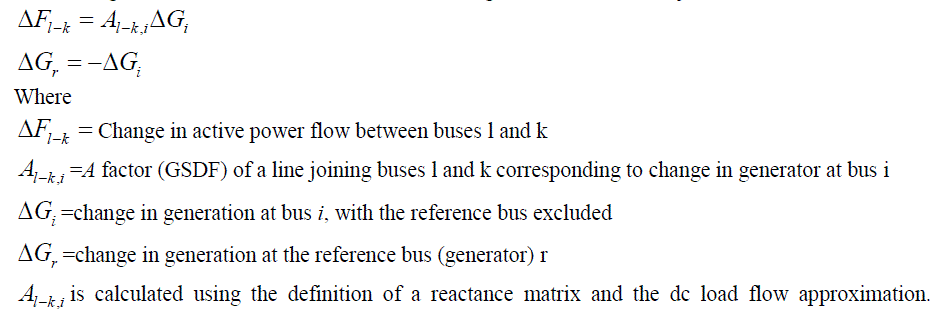 |
| B) Generalized Generation Distribution Factors (GGDFs or D factors) |
| They determine the impact of each generator on active power flows; thus they can be negative as well. Since
GGDFs are based on the dc model, they can only be used for active power flows. GGDFs or D factors are defined as |
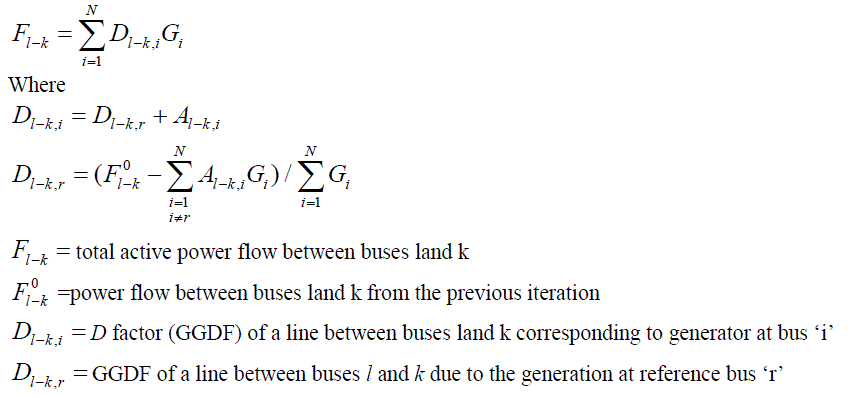 |
| i G =total generation at bus ‗i‘ |
| C) Algorithm for transmission cost allocation using dc load flow |
| Step1: Run the DC load flow for base case data. |
| Step2: Evaluate the line flows of each line and slack bus power in the given power system. |
| Step3: Read the line lengths in miles of the system. |
| Step4: Fix the unit rate i.e.,$/MW/Mile |
| Step5: Calculate A factors. |
| Step6: Calculate D factors using A factors. |
| Step7: Evaluate the tracing of line flow of each line. |
| Step8: Evaluate total cost of each generator. |
| Step9: Evaluate the transaction cost for each generator. |
 |
| Step8: Calculate cost ($/MW) for each generator. |
 |
BIALEK TRACING METHOD |
| Tracing methods determine the contribution of transmission users to transmission usage tracing methods may
be used for transmission pricing and recovering fixed transmission costs. In this section, we will discuss Bialek‘s
tracing method. And it is generally based on the proportional sharing principle. |
| A) Proportional Sharing Principle Method (PSP-Method) |
| Proportional Sharing Principle method determines the contribution of transmission users to transmission
usage. This method may be used for transmission pricing and recovering fixed transmission costs.In this method, it is
assumed that nodal inflows are shared proportionally among nodal outflows. This method uses a topological approach
to determine the contribution of individual generators or loads to every line flow based on the calculation of topological
distribution factors. This method can deal with both dc-power flow and ac power flows; that is, it can be used to find
contributions of both active and reactive power flows. Proportional Sharing Principle method considers: |
| Two flows in each line, one entering the line and the other exiting the line. |
| Generation and load at each bus. |
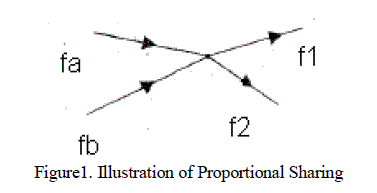 |
| The main principle used to trace the power flow will be that proportional sharing. This principle follows the
Kirchhoff current law as shown in Fig.1. The figure shows four lines connected to a node. The outflows (f1 and f2) can
be represented in terms of the inflows (fa and fb); in other words, we can determine how much of f1 comes from fa and
how much of f1comes from fb, |
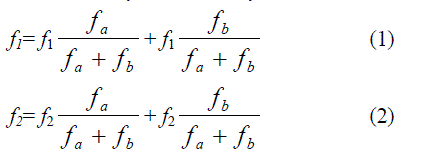 |
| B) Performance of Bialek’s Tracing Method |
| In Bialek‘s tracing method, it is assumed that nodal inflows are shared proportionally among nodal outflows. This
method uses a topological approach to determine the contribution of individual generators or loads to every line flow
based on the calculation of topological distribution factors. This method can deal with both dc power flow and ac
power flows; that is, it can be used to find contributions of both active and reactive power flows.In this method
algorithm works, we define the gross demand as the sum of a particular load and its allocated part of the total
transmission loss. The total gross demand in a system is equal to the total actual generation. Topological distribution
factors are given by the following equation in which ,
g
ij k D refers to the th k generator‘s contribution to line i–j flow. |
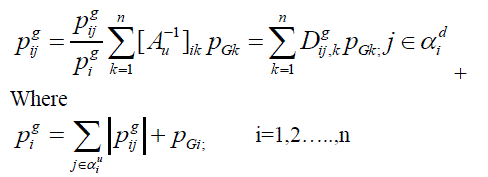 |
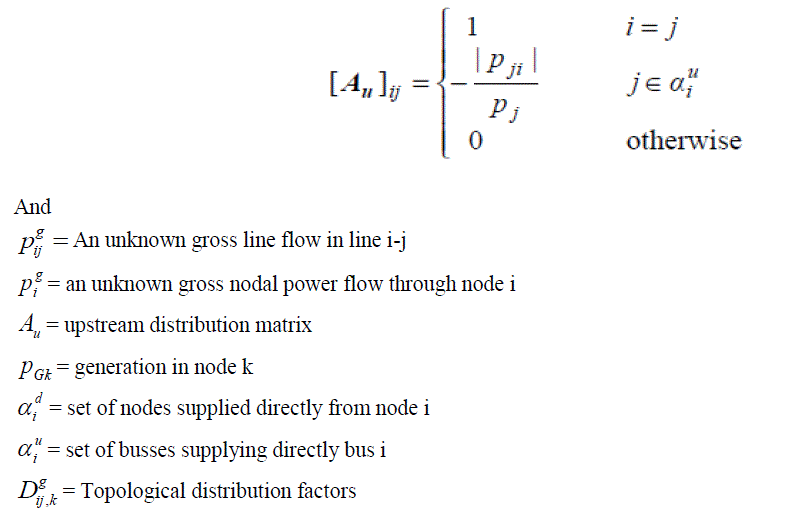 |
| The gross power at any node is equal to the generated power at the node plus the imported power flows from
neighboring nodes. The total usage of the network by the kth generator (UGK) is calculated by summing up the
individual contributions (multiplied by line weights) of that generator to line flows. This is given by: |
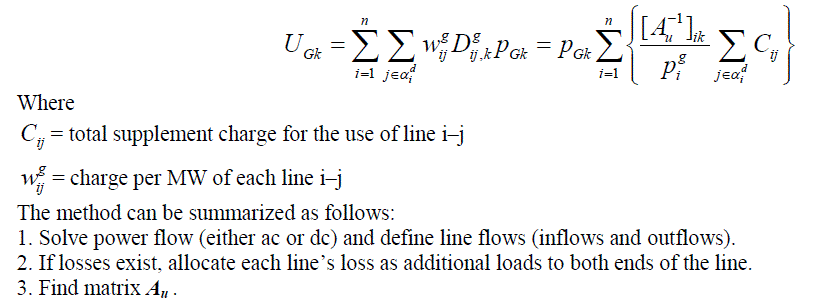 |
| 4. Define generation vector PG |
| 5. Invert matrix Au(i.e.,
1
u A-
) |
 |
 |
| The downstream-looking method that allocates usage charges to individual loads would use the same methodology.
Allocation of generators to branch flows as, (Up Stream) |
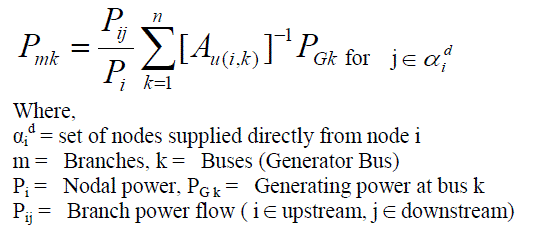 |
| C) Algorithm for bialek method |
| Step1: Run the AC load flow for base case data. |
| Step2: Evaluate the line flows of each line and slack bus power in the given power system. |
| Step3: Read the line lengths in miles of the system. |
| Step4: Fix the unit rate i.e.,$/MVA/Mile |
| Step6: Evaluate the tracing of line flow of each line with Bialek method. |
| Step8: Evaluate total cost of each generator. |
| Step9: Evaluate the transaction cost for each generator. |
 |
| Step10: Calculate cost ($/MW) for each generator. |
 |
RESULT AND DISCUSSION |
| The results of MW-Mile ,MVA-Mile,GGDF and Bialek tracing methods as shown in tables A,B,C and D.These results
is obtained based on the algorithm steps. When comparing all the results Bialek tracing method is the best way of
transmission pricing, among all embedded cost based methods. |
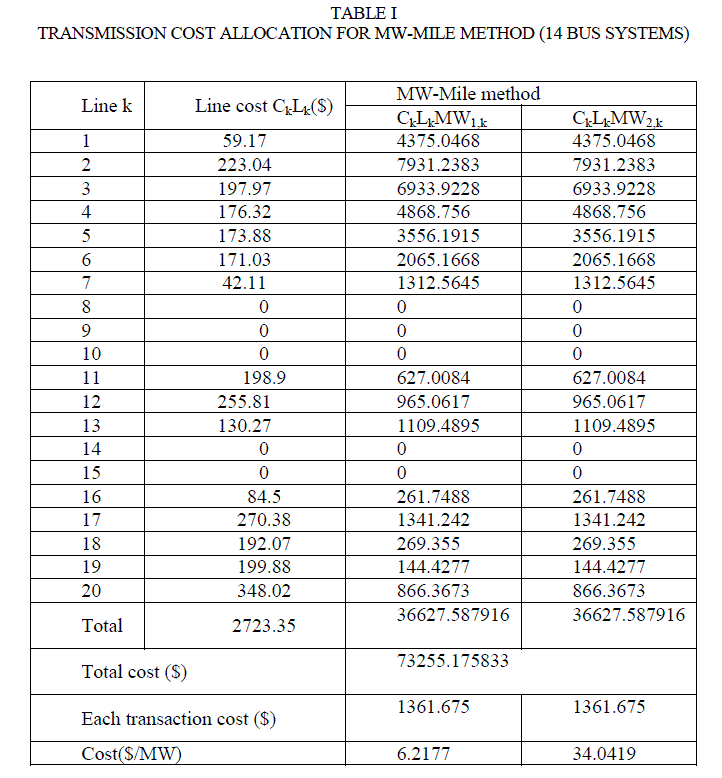 |
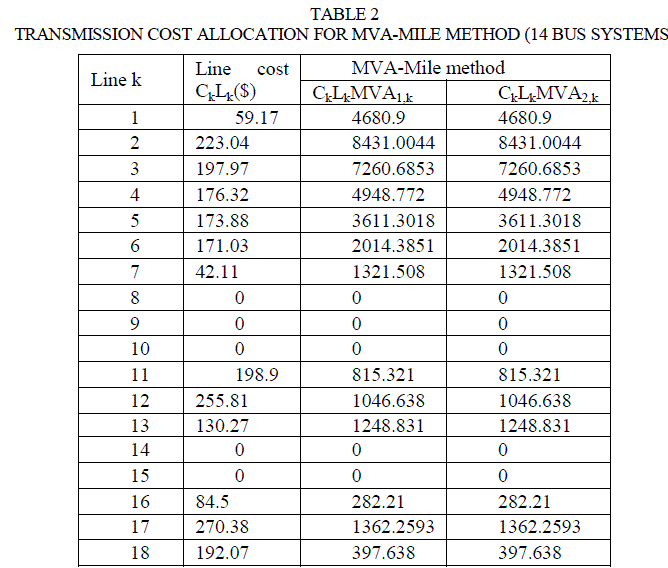 |
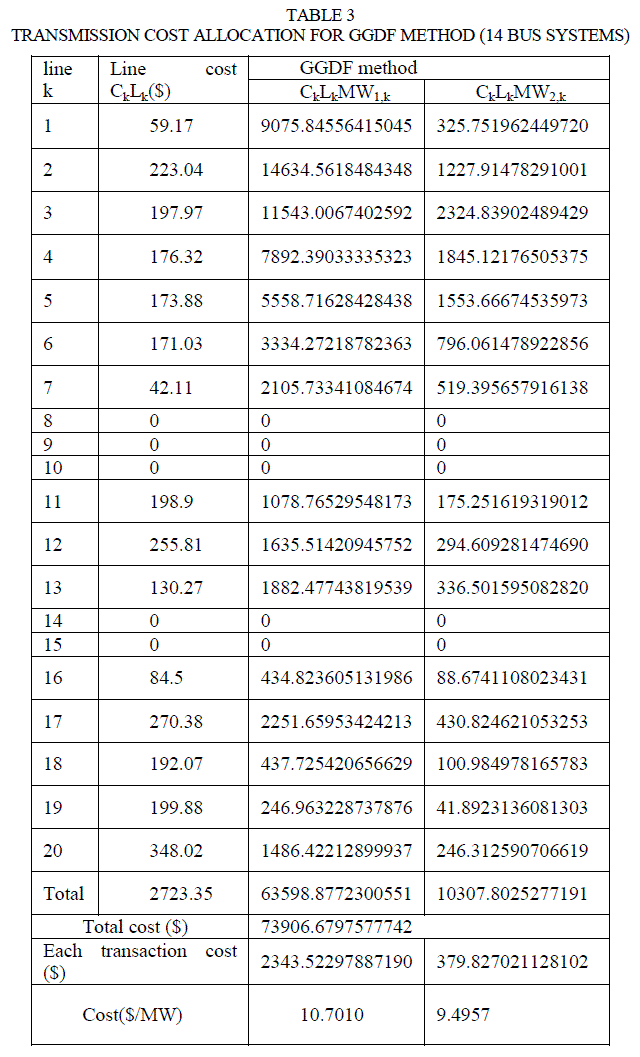 |
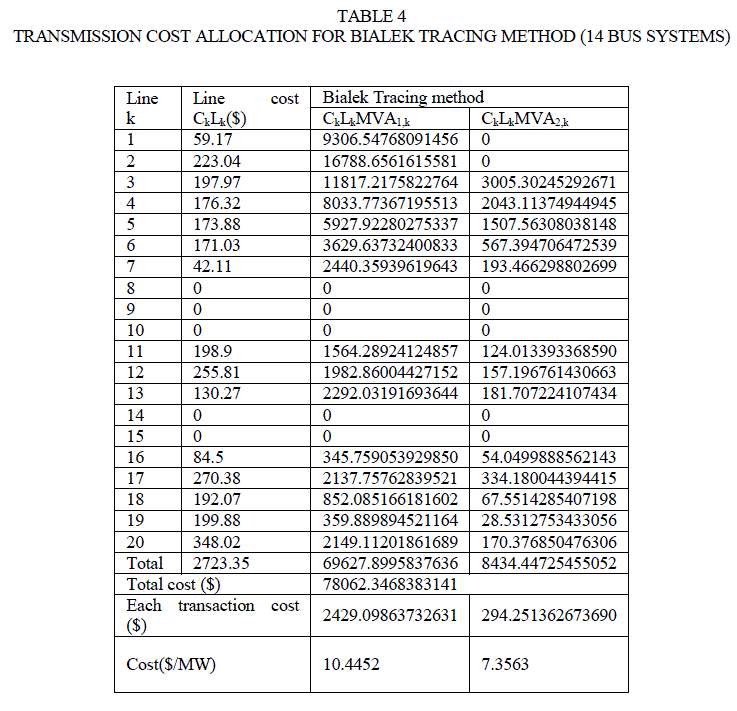 |
CONCLUSION |
| In this paper embedded cost based methods of transmission pricing have been discussed. Different cost
components incurred by the transmission transaction were explained. Case studies of MW-Mile method, MVA-Mile
method, Distribution factors method and Bialek tracing method for IEEE14bus are presented. Bialek tracing method is
the best way of transmission pricing, among all embedded cost based methods. It is observed that combination of
incremental and embedded cost based methods could result in the recovery of true transmission system costs. |
References |
- Mohamed A.M. Shaaban ―Cost-based Pricing of Transmission System Services: An OverviewPortFouard 42523, Port Said, EGYPT
- Francisco Danitz, Hugh rRudnick, Juan Zolezzi and David WattsUse Based Allocation Methods for Payment of Electricity Transmission Systems ―IEEE-2002.
- Mohammed Shahidehpour, HatimYamin, Zuyi Li, ―Market Operations in Electric Power System Forecasting, Scheduling and Risk Mangements, John Wiley & Sons Ltd, Newyork
- J. Bialek, ―Tracing the Flow of Electricity, IEE Proc.-Genet Trunsm, Distrib,Vol. 143, No. 4, pp.313320,July 1996.
- Su, C.T., and Liaw, J.H.: ―Power wheeling pricing using power tracing and MVA-KM method. Proc. Power Tech., IEEE Porto, 10–13 Sept.2001, Vol. 1, pp. SSM1
- P.K. Iyambo,andR.Tzoneva Member IEEE ―Transient stability analysis of the IEEE 14 bus electricalpowersystem ― 2007 IEEE
- Niranjankumar, student member IEEE Y.R.V.Reddy, Devadutta das, N.P.Padhy, senior member IEEE2001―Transmission cost allocation y using MW-Mile approaches in restructured Indian powersystem
- DariushShirmohammadi ,MarioV.P.Pereira, power system research ― Some fundamental technical concepts about cost based transmission pricing ―1995 IEEE
- DariushShirmohammadi, ChithraRajagopalan, Chifong L .Thomas senior member, ―Cost of transmission transactions an introductcion1991 IEEE
- J.W. Bialek and P.A. Kattumanpropotional sharing assumption intracingmethodolaoggy,IEEE 2004
|